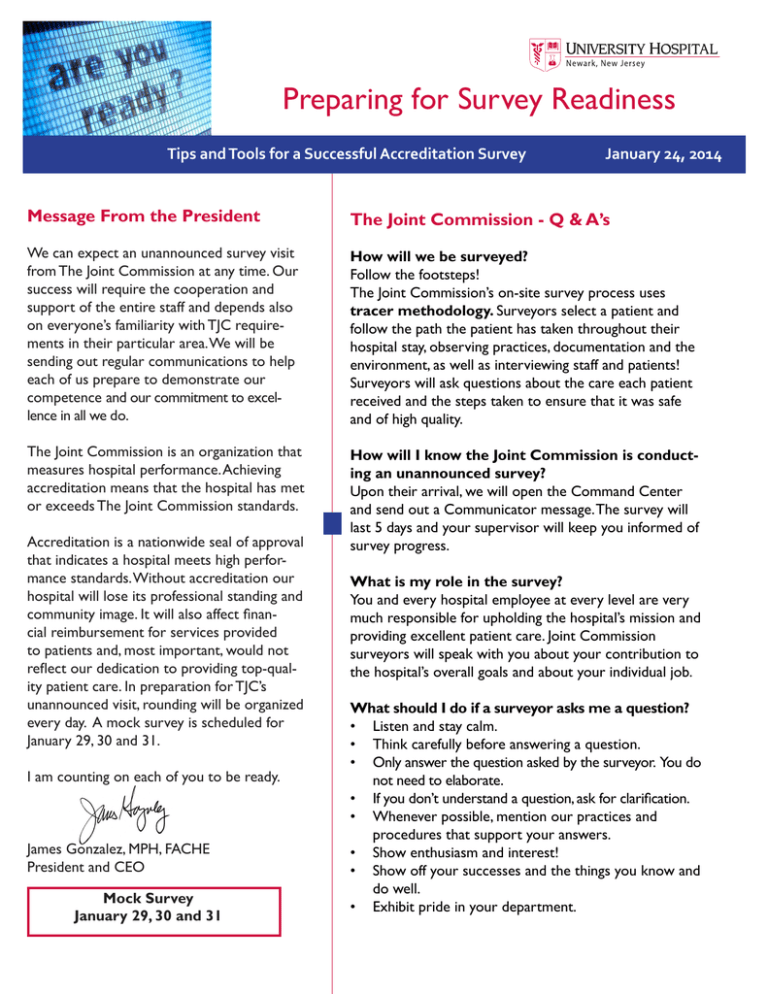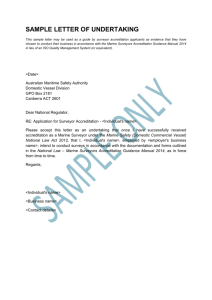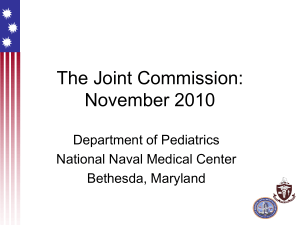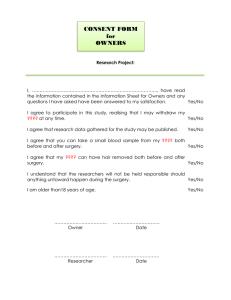Preparing for Survey Readiness
advertisement

Preparing for Survey Readiness Tips and Tools for a Successful Accreditation Survey January 24, 2014 Message From the President The Joint Commission - Q & A’s We can expect an unannounced survey visit from The Joint Commission at any time. Our success will require the cooperation and support of the entire staff and depends also on everyone’s familiarity with TJC requirements in their particular area. We will be sending out regular communications to help each of us prepare to demonstrate our competence and our commitment to excellence in all we do. How will we be surveyed? Follow the footsteps! The Joint Commission’s on-site survey process uses tracer methodology. Surveyors select a patient and follow the path the patient has taken throughout their hospital stay, observing practices, documentation and the environment, as well as interviewing staff and patients! Surveyors will ask questions about the care each patient received and the steps taken to ensure that it was safe and of high quality. The Joint Commission is an organization that measures hospital performance. Achieving accreditation means that the hospital has met or exceeds The Joint Commission standards. How will I know the Joint Commission is conducting an unannounced survey? Upon their arrival, we will open the Command Center and send out a Communicator message. The survey will last 5 days and your supervisor will keep you informed of survey progress. Accreditation is a nationwide seal of approval that indicates a hospital meets high performance standards. Without accreditation our hospital will lose its professional standing and community image. It will also affect financial reimbursement for services provided to patients and, most important, would not reflect our dedication to providing top-quality patient care. In preparation for TJC’s unannounced visit, rounding will be organized every day. A mock survey is scheduled for January 29, 30 and 31. I am counting on each of you to be ready. James Gonzalez, MPH, FACHE President and CEO Mock Survey January 29, 30 and 31 What is my role in the survey? You and every hospital employee at every level are very much responsible for upholding the hospital’s mission and providing excellent patient care. Joint Commission surveyors will speak with you about your contribution to the hospital’s overall goals and about your individual job. What should I do if a surveyor asks me a question? • Listen and stay calm. • Think carefully before answering a question. • Only answer the question asked by the surveyor. You do not need to elaborate. • If you don’t understand a question, ask for clarification. • Whenever possible, mention our practices and procedures that support your answers. • Show enthusiasm and interest! • Show off your successes and the things you know and do well. • Exhibit pride in your department. Who is in charge of survey preparation in my area? Your department director or manager is responsible for the survey readiness of your area, in coordination with the University Hospital Leadership Team and the Regulatory Readiness Team. However,YOU are also responsible for your own participation and preparedness. Who sees the results of our survey? Anyone who wants to. The results are made public and available on the Internet. Our competitors, managed care companies, referring physicians and – most importantly – our patients and their families will be able to read the details of our performance. Emergency Codes Non-Medical Emergencies: 222 Medical Emergencies: 111 “Code Red + Location” - Fire - All floors must clear the hallways and close all doors. Remember... R-A-C-E (fire instructions) Rescue - Alarm - Contain - Extinguish P - A - S - S (for fire extinguishers) (Pull - Aim - Squeeze - Sweep “Code Red All Clear” - Fire alarm has been cleared. - Resume activities. “CodeTriage in the Command Post” - Internal Disaster - Return to work area. Do not use phones. - Implement department/unit responsibilities. 2014 Hospital National Patient Safety Goals The purpose of the National Patient Safety Goals is to improve patient safety. The goals focus on problems in health care safety and how to avoid them. Identify Patients Correctly Use at least two ways to identify patients. For example, use the patient’s name and medical record number. This is done to ensure that each patient gets the correct medicine and treatment. It also confirms that the correct patient gets the correct blood when they get a blood transfusion. Improve Staff Communications Improve the effectiveness of communication among caregivers (“read back”, timely report of critical values, handoff communication). Use Medications Safely Label all medications before procedures. Reduce the possibility of harm for patients on anticoagulation therapy. Maintain and communicate accurate patient medication information (Medication Reconciliation). Use Alarms Safely Make improvements to ensure that alarms on medical equipment are heard and responded to on time. “Code Triage in the ED” - External Disaster - Do not release information to the media. Prevent Infection Be vigilant about hand-washing protocol. Use the “proven guidelines” to prevent infection (difficult to treat infections, blood from central lines, after surgery and urinary tract infections caused by catheters). “Code Triage All Clear” - Disaster has ended. - Resume activities. Identify Patient Safety Risks Learn which patients are most likely to try and commit suicide. “Code Amber” - Infant/child abduction - Be observant of people. - Notify Public Safety at 222 if you see anything suspicious. Prevent Mistakes in Surgery Make sure that the correct surgery is done on the correct patient and at the correct place on the patient’s body. Mark the correct place on the patient’s body where the surgery is to be done. Pause before the surgery to make sure that a mistake is not being made. (Take a “time out”). “Code Blue + Location” - Cardiac arrest “Dr. Band-Aid + Location” - Staff and visitor accidents/emergencies OUR MISSION To improve the quality of life for all those we touch through excellence in patient care, education, research and community service. OUR VISION To create the best possible environment for our patients to heal, our physicians to practice and our employees to work. To learn more about the National Patient Safety Goals, contact Aaron Weinberg, Patient Safety Department at 2-6373 or by email at: weinbeam@uhnj.org This article, created for the staff, contains a reader-friendly version of the 2014 National Patient Goals.The official language of the goals can be found at www.jointcommission.org Working together, we can have a successful survey!




